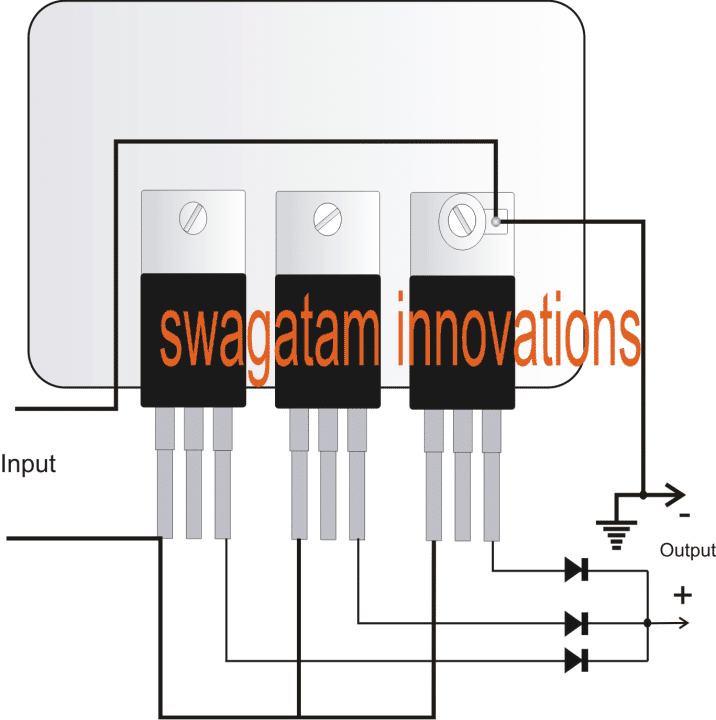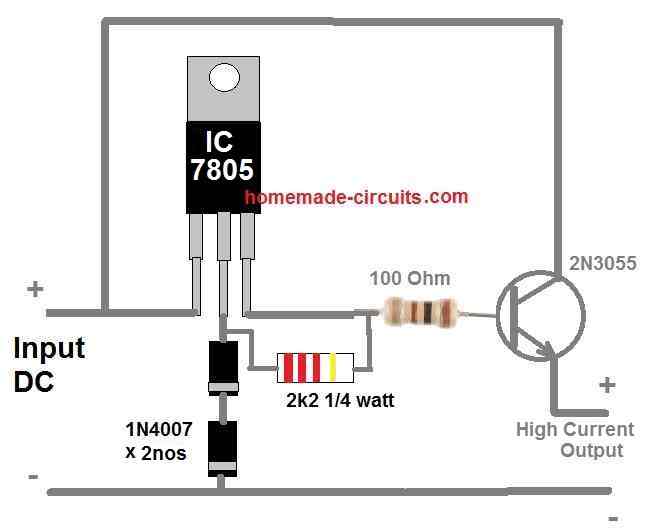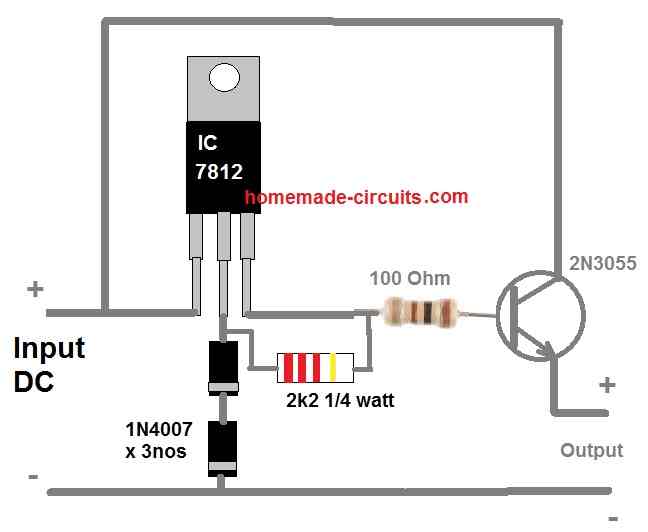In this post we try to understand how we can connect some famous voltage regulator ICs like 7812, 7805, etc. in parallel way so that we can get more current from them which is higher than their normal current.
Actually these voltage regulator ICs like 78XX series, mostly have their maximum current output fixed to one constant value only, like may be 1 amp or 1.5 amp.
So if we want to get more current than this then normally we must use some extra transistors outside and also we need to build some complicated circuit around them. But for many new hobby users this external transistor method can become very difficult to understand and build correctly. So because of this problem, we feel that just connecting 2 or 3 of these ICs in parallel can be one very easy solution.
This idea was actually asked by one of our visitors, Mr. Danny.
Technical Question from Mr. Danny:
Sir,
Can I use three L7815 voltage regulator ICs in parallel way so that I can get 15 volt and 4 amps DC output from one DC supply of 20 volt 5 amp?
Sir because LM338 and other similar 5 amp ICs are not available in my town, I thought to use three 7815 ICs together in parallel. Will this method work properly? If yes then please tell me how I should connect them?
Should I connect input pins of all three 7815 ICs using one single common wire? Or should I separate their input using one 2 amp diode for each IC? And what about the output? Should I separate output pins also or I can join them using one common wire? And I believe I can connect all ground pins together using one single wire. Am I right Sir? Please help me.
Solving the Circuit Request:
So even though many engineers or technical persons do not recommend this method, still we can solve this issue in a very simple way by just connecting the 7815 regulators in parallel, just like shown in the circuit diagram below.
In this connection, we can see that input pins and ground pins of all the ICs are joined together using common wires, but output pins of the ICs are connected separately using individual diodes for each one.
But even though this parallel connection looks easy, it can have one serious drawback. That drawback is: all the ICs will not have same internal specs or same current sharing ability. So this means that one of the ICs may start giving more current than others. This can make it hotter and overheat quickly.
Even though these ICs have internal thermal shutdown feature which can save them from getting damaged, still we should not allow this to happen, because it is not good idea to let any IC become hot for no reason.
We can fix this heating problem very easily. We only have to mount all the three 7815 ICs on one single large aluminium heatsink plate. This heatsink will then spread the heat equally across all the ICs and this will force all of them to share current equally.
Also remember that all 78XX ICs have their metal tab connected with their ground pin internally. So there is no need to use any mica isolator or washer between IC and heatsink. You can just screw them directly on the common aluminium plate without any electrical issue.
So finally, when we use one common heatsink for all then we can stay tension-free. The heat will get divided properly and all three ICs will give equal current from their outputs, and the combined output current will become much higher, as we wanted.
Circuit Diagram

High Current from IC 7805 using 2N3055 External Transistor
So even though using 7805 or 7812 ICs in parallel looks like one good and simple method to get more current output from these regulator chips, still we can say that one better and more proper option can be by using one external power transistor, just like how it is shown in the following diagram.


So from this type of setup, we can actually get as high as 5 amp current output just by using one single 7805 IC together with one external power transistor like 2N3055. The voltage at the output will be as properly regulated as what we normally get from any 78XX IC.
Now if we are using 7805 then we will get around 5 V 5 amp at the output. But if we are using 7812 instead, then we will get around 12 V 5 amp at the output. That output voltage will totally depend on which 78XX IC number we are using in the circuit.
Also if we want to tweak or adjust the output voltage slightly higher, then we can do that just by adding or reducing number of 1N4007 diodes at the GND leg of the IC. More number of diodes will slightly lift the output voltage higher.
And if we want to control or adjust the current output then we can do that by changing the value of that 100 ohm base resistor which is connected with the 2N3055 base. Lower resistor value will give more current, and higher value will reduce the current.
Leave a Reply